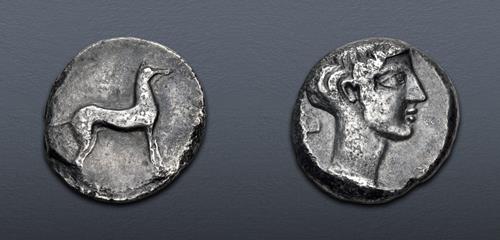
|
SICILY, Motya. Circa 410-405 BC. AR Didrachm (20mm, 7.70 g, 10h). VF.
Triton XXVII
Lot: 107. Estimated: $ 1 500
Greek, Coin-in-Hand Video, Silver
Sold For $ 4 750. This amount does not include the buyer’s fee.
Go to Live
|
|
SICILY, Motya. Circa 410-405 BC. AR Didrachm (20mm, 7.70 g, 10h). Hound standing right / Head of female right; ivy leaf to left, [mṭv’ (in Punic) to right]. Jenkins, Punic 27 (O13/R16); Campana 8 var. B/a; HGC 2, 927; SNG Ashmolean 1858 = SNG Lockett 2503 (same dies). Deeply toned, minor roughness. VF. Rare.
From the L.H. Collection.
The Punic didrachm series was minted during a period of strife in Sicilian politics. The Athenians had somewhat recently been thrown off the island by the victorious Syracusans in 413 BC, but the true purpose of the Athenian expedition had supposedly been to help the Segestans against their bitter enemies in Selinos. After the Athenian defeat, Selinos attacked again in 410 BC and the Elymian city of Segesta now called on Carthage for aid. Carthage proceeded to effectively vassalize Segesta and then capture and destroy both Selinos and Himera. This shocked much of the rest of Greek Sicily, but after the hard fought effort to expel the Athenians they did not immediately interfere. It was a Syracusan exile named Hermocrates leading mercenaries and citizens of the destroyed city of Himera that sparked the next phase of the war. He raided Punic territory in western Sicily in 407 BC, then headed back east and died in an attempt to take power in Syracuse. His raids precipitated a Punic invasion of western Sicily that would lead to the destruction of numerous cities in the years of war that followed, most prominently Akragas and Motya.
Considering the previously discussed historical context, the didrachm series, minted for use by the Siculo-Punic cities of Motya and Panormos, was most likely used to help pay for the massive armies and fleets that Carthage raised to fight in their long Sicilian conflict. It is also likely, given Segestan experience minting didrachms and the evidence for die sharing between Segesta, Motya, and Panormos, that Segesta, in its role as a new Punic dependency, was tasked with helping the Carthaginians with their didrachm production. The existence of a number of hybrids mixing the dies of Segesta, Motya, and Panormos points to the existence of a central mint, but which city housed that central mint is not agreed on by scholars. Jenkins and Hurter argue that the central mint’s location was Panormos, while Rutter argues convincingly that the likely location was Carthage’s new dependency Segesta. Considering the historical context of the didrachm series, it seems likely that the central mint was in fact Segesta.
The final winners of all Triton XXVII lots will be determined at the live public sale that will be held on 9-10 January 2024.
Triton XXVII – Session One – Lot 1-337 will be held Tuesday morning, 9 January 2024 beginning at 9:00 AM ET.
Winning bids are subject to a 22.5% buyer's fee for bids placed on this website and 25% for all others.
We recognize that our users may have various Internet Browsers and Operating Systems. We like our visitors to have the best possible experience when using our bidding platform. However, we do recognize that it is impossible to develop applications that work identically, efficiently and effectively on all web browsers. The CNG bidding platform supports the latest stable major version and stable previous version of Chrome and Firefox.
|
